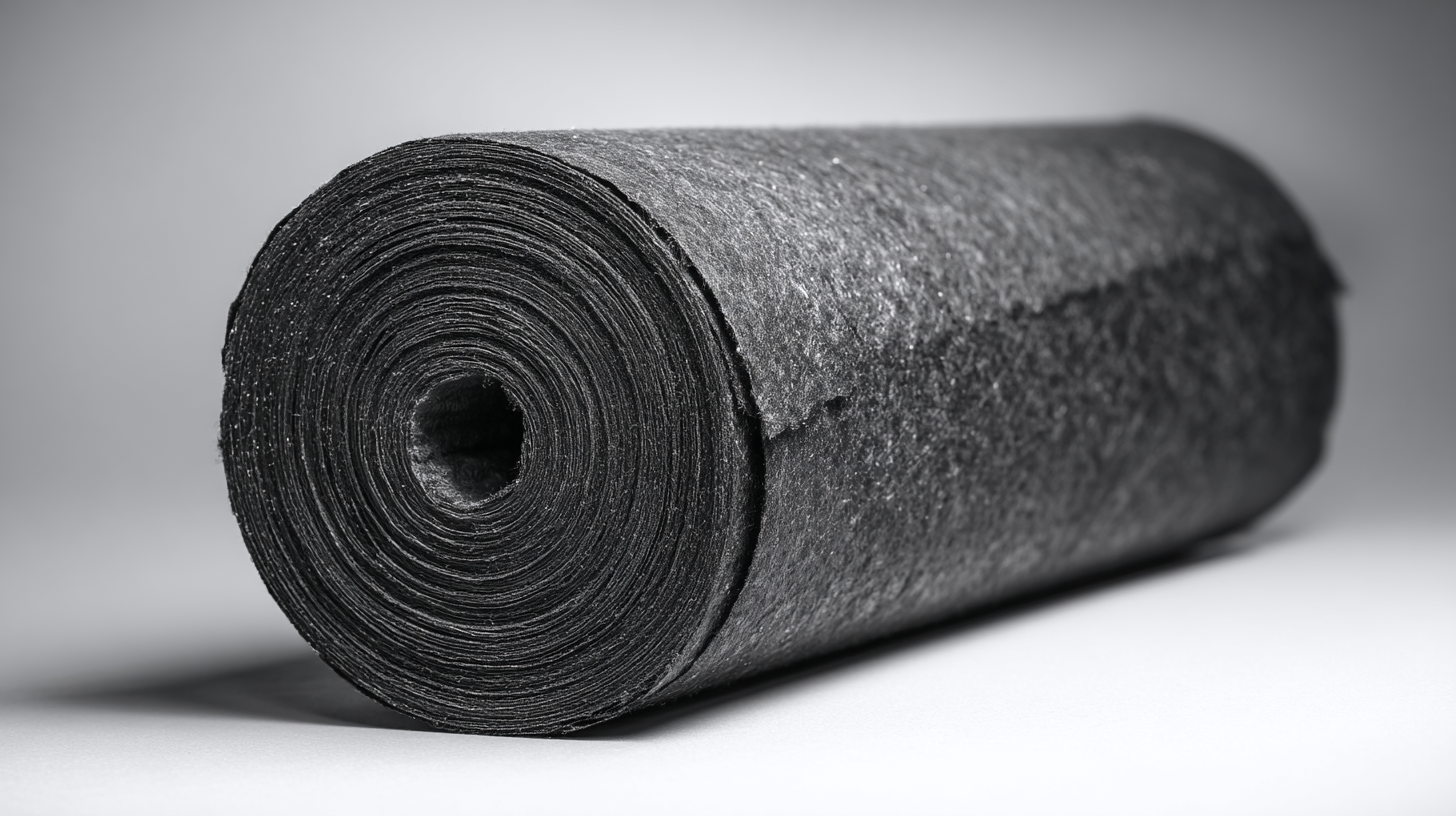Inquiry
Form loading...
- Phone
- E-mail
The evolution of Geo Synthetic Material has significantly transformed the landscape of construction and civil engineering projects, driving innovation and efficiency across various sectors. According to a report by Grand View Research, the global geo-synthetics market size was valued at USD 10.91 billion in 2020 and is projected to grow at a compound annual growth rate (CAGR) of 11.7% from 2021 to 2028. This remarkable growth can be attributed to the increasing demand for sustainable construction practices and the need for durable solutions in soil stabilization, drainage, and erosion control. As we assess the impact of these advancements, it becomes crucial to understand the best geo synthetic materials available today and their implications for future projects. This checklist aims to highlight key developments in the industry, paving the way for enhanced project planning and execution.

 Geo synthetic materials have significantly evolved over the decades, originally emerging in the mid-20th century as simple fabrics designed for erosion control. Early versions primarily aimed to provide basic structural support and soil stabilization. However, innovations in polymer science led to the development of more sophisticated materials like geotextiles, geomembranes, and geogrids, which are now essential in civil engineering and construction projects. These modern geo synthetics enhance drainage, reduce soil erosion, and improve overall site stability, marking a significant advancement from their rudimentary predecessors.
Geo synthetic materials have significantly evolved over the decades, originally emerging in the mid-20th century as simple fabrics designed for erosion control. Early versions primarily aimed to provide basic structural support and soil stabilization. However, innovations in polymer science led to the development of more sophisticated materials like geotextiles, geomembranes, and geogrids, which are now essential in civil engineering and construction projects. These modern geo synthetics enhance drainage, reduce soil erosion, and improve overall site stability, marking a significant advancement from their rudimentary predecessors.
**Tip:** When selecting geo synthetic materials for your project, consider the specific environmental conditions and loads they will face. Understanding the material properties, such as permeability and tensile strength, can optimize performance and project longevity.
Today's geo synthetic solutions incorporate advanced technologies and materials, allowing for increased functionality and efficiency. From lightweight geocomposites to multi-layer systems, these innovations not only streamline construction processes but also minimize environmental impact. Their versatility makes them applicable in various sectors such as transportation, waste management, and agriculture.
**Tip:** Always consult with a geo synthetic specialist to ensure the chosen materials comply with industry standards and project specifications, which can prevent costly mistakes down the line.
The evolution of geosynthetic materials has been remarkable, particularly in the realms of durability, efficiency, and sustainability. Key innovations in geosynthetic technology over the years include advancements in polymer formulations, improved manufacturing techniques, and the integration of smart technologies. These developments have not only enhanced the material’s mechanical properties but also its environmental compatibility, making geosynthetics an essential component in modern engineering projects.
According to industry reports, the global geosynthetics market is projected to reach USD 16 billion by 2026, growing at a CAGR of 12%. This growth is fueled by increasing demand for infrastructure development and the need for cost-effective solutions in construction, waste management, and soil stabilization. As projects grow more complex, geosynthetic innovations, such as the incorporation of geotextiles and geomembranes in infrastructure systems, will play an integral role in ensuring project longevity and ecological balance.
Tips: When selecting geosynthetic materials for a project, consider the specific environmental conditions and load requirements. Also, keep abreast of technological advancements in geosynthetics, as new materials can offer enhanced performance and sustainability benefits. Lastly, consult with industry experts to ensure optimal material selection and application strategies, as this can significantly impact the overall success of your project.
Geosynthetics have revolutionized modern engineering projects by providing innovative solutions for various applications. These materials, which are used for drainage, reinforcement, and separation, have proven essential in stabilizing earth structures, enhancing their mechanical properties through tensile reinforcement. The long history of geosynthetics, particularly in projects initiated by the US Department of Agriculture (USDA) Forest Service, highlights their vital role in infrastructure development, ensuring the durability and reliability of national forest roads.
Recent advancements in geosynthetic technology, such as the introduction of GEOTUBE marine technology, are paving the way for significant improvements in coastal reclamation projects. The Seri Tanjung Pinang Phase 2B (STP2B) project exemplifies this progress, demonstrating the efficacy of geosynthetics in addressing contemporary engineering challenges. As the demand for sustainable and cost-effective construction solutions grows, the geosynthetic cementitious composite mats market is expected to surge, reflecting the increasing reliance on these materials in both urban and natural environments. With continuous innovations and applications, geosynthetics are set to play a pivotal role in shaping the future of engineering projects worldwide.
 Geo synthetic materials have significantly changed the construction landscape, offering innovative solutions that are both efficient and environmentally conscious. As the industry evolves, understanding the environmental implications of these materials becomes crucial. Geo synthetics, such as geotextiles and geomembranes, play a vital role in managing soil erosion, enhancing drainage, and providing stabilization, which ultimately contribute to reducing the carbon footprint of construction projects.
Geo synthetic materials have significantly changed the construction landscape, offering innovative solutions that are both efficient and environmentally conscious. As the industry evolves, understanding the environmental implications of these materials becomes crucial. Geo synthetics, such as geotextiles and geomembranes, play a vital role in managing soil erosion, enhancing drainage, and providing stabilization, which ultimately contribute to reducing the carbon footprint of construction projects.
Tips for choosing environmentally friendly geo synthetics include opting for recycled materials whenever possible. This not only minimizes waste but also supports a circular economy. Additionally, evaluating the lifecycle of geo synthetic products can help in selecting options that offer durability and performance without significant environmental degradation. Adopting practices that focus on sustainability can lead to innovative project designs that mitigate adverse impacts while promoting the use of geo synthetics.
It's also beneficial to stay informed about the certification standards for geo synthetic materials, which can ensure that your choices are aligned with environmental regulations and best practices. By prioritizing eco-friendly materials in construction, professionals can enhance project sustainability and make a positive impact on the environment while meeting the growing demands for efficient infrastructure solutions.
In recent years, the field of geo synthetic materials has experienced significant advancements, prompting a reassessment of future trends in both material development and project implementation. Modern geo synthetics now offer enhanced durability and environmental compatibility, driven by innovations in manufacturing processes and materials science. These improvements not only reduce the ecological footprint of construction projects but also enhance the performance and longevity of infrastructure, making them more resilient in the wake of climate change challenges.
As we look ahead, one notable trend is the increasing incorporation of smart technologies within geo synthetic materials. For instance, integrating sensors into geo synthetics allows for real-time monitoring of soil stability and moisture levels, which can be invaluable for managing large-scale projects and ensuring safety. Additionally, the emphasis on sustainability is pushing the industry towards biopolymer-based geo synthetics, which promise not only performance but also a reduced environmental impact. These evolving materials are poised to redefine project implementation strategies, as they facilitate more efficient designs, lower construction costs, and improved lifecycle management, ultimately leading to smarter and more sustainable infrastructure solutions.
| Material Type | Key Characteristics | Current Applications | Future Trends | Sustainability Impact |
|---|---|---|---|---|
| Geotextiles | High permeability, soil stabilization | Road construction, erosion control | Smart textiles with sensors | Reduces landfill waste through recycling |
| Geogrids | Reinforcement capabilities, load distribution | Subgrade stabilization, embankment support | Nanomaterials for enhanced performance | Lower CO2 emissions during production |
| Geomembranes | Impermeable, chemical resistance | Landfills, water containment | Biodegradable options, increased durability | Enhanced protection of natural resources |
| Geocomposites | Combination of materials for multi-functionality | Drainage systems, landfill caps | Smart geocomposites with monitoring capabilities | Increased resource efficiency |
